How to Generate OTB Random Positions
Daily, we play numerous random chess variants in CV's Game Courier. The Game Courier gratiously automatically generates the random positions for us, and off we go to play our games...But how do you generate random positions for Over The Board (OTB) random games?
There are some well documented works about how to generate 8x8 Fischer Random Chess positions.
The purpose of this work is to give the reader a general idea of how to generate random positions for any size boards (8x8, 9x9, 10x8...)
The random techniques explained here are by no mean all inclusive. There are numerous other ways of generating random positions. Feel free to add more random ideas in the comment section.
Here I'm just showing a few of the ways to randomize positions.
Equipment
Simple, dice and different size coins.A common 6-side die is all you need to generate most random positions for all size random chess variants. Other size dice (4-side, 8-side, 10-side...) are useful in to ease and speed up the randomizing process for some positions, but these dice are not always readily available (mind you I always carry them with my chess set and clock).
Three different size coins (i.e. penny, nickel and dime) is also enough to randomize positions in a fly if a 6-side die is not available.
Players are allowed to alternate turns rolling the dice or flipping the coins if they like.
The techniques below will give you the random position from the White player's point of view. The Black player will place his/her pieces according to the symmetry rules (direct or reversed) of the game. Or he will use the rules from his perspective if the game allows for doubled random positions (i.e. English Random Chess).
Randomizing Techniques
Dice
1.0 Roll the die - Simple! You roll a 6-side die, and will get a number value from 1 to 6. In some randomizing situations the roll value may be higher than the available empty squares. In those situations just roll again.1.1 'Heads or Tails' roll - In some situations when you are using a 6-side die you need to make a choice between two options (i.e. two empty squares, or choice of dark or light squares). Just roll the die, and if the roll yields an odd number, it's heads; otherwise on an even number roll it's tails. Valuewise: heads is 1, tails is 2. Options (2.1a) or (2.1b) below will then apply.
Coin Tosses
2.0 One, two or three coins of different sizes may be used (i.e. dime, penny and nickel), depending the needs.2.1 Heads or tails - Use one coin if there is only two options (i.e. two empty squares, or choice of dark or light squares). Heads is the number value 1, tails is 2. One the following options will apply)
2.1a If used to place pieces, on heads place the piece on the first available square to the left, on tails place it on the second available square from the left (the first available square from the right).
2.1b If used to select dark or white squares, on heads it's dark squares, on tails it's lights squares.
2.2 Up to 4 choices - Two coins will give you 4 (2x2) different heads & tails combinations.
Make up a little chart with the posible coin tosses:
| Coin Toss | Penny | Nickel |
|---|---|---|
| 1 | head | head |
| 2 | head | tail |
| 3 | tail | head |
| 4 | tail | tail |
Each coin toss combination will receive the number value on the left, which will be used as the number of squares to count below. This would be the equivalent to rolling a 4-side die.
In some randomizing situations the coins toss value may be higher than the available empty squares. In those situations just roll again.
2.3 Up to 8 choices - Three coins will give you 8 (2x2x2) different heads & tails combinations.
Make up a little chart with the posible coin tosses:
| Coin Toss | Dime | Penny | Nickel |
|---|---|---|---|
| 1 | head | head | head |
| 2 | head | head | tail |
| 3 | head | tail | head |
| 4 | head | tail | tail |
| 5 | tail | head | head |
| 6 | tail | head | tail |
| 7 | tail | tail | head |
| 8 | tail | tail | tail |
Each coin toss combination will receive the number value on the left, which will be used as the number of squares to count. This would be the equivalent to rolling a 8-side die.
In some randomizing situations the coins toss value may be higher than the available empty squares. In those situations just toss the coins again.
If at any time the number of empty squares drops to 4 or less, discard one of the coins (i.e. the dime) and continue using the process above with 2 coins (2.2).
Place the Bishops
3.0 Most random variants call for the Bishops to be placed in different color squares. A few others allow Bishops to start on the same color squares.3.1 Opposite Color Squares - Roll the dice (1.0) or toss two or three coins (2.2 or 2.3) depending on the number of available squares (two coins for up to 4 available squares, three coins for more). Use the value to count from left to right the number of empty squares, skipping over any dark squares that are occupied. Repeat the process for the 2nd Bishop, but the this time counting on the light squares.
3.2 Same Color Squares Allowed - Toss one coin (2.1) or do a 'Heads & Tails roll' (1.1). Heads stands for the dark squares, tails for the light squares. Roll the dice or toss the coins. Use the value to count from left to right the number of empty squares, skipping over any dark or light squares (as chosen by the 'Heads and Tails' toss or roll just done) that are occupied. Repeat the process (3.2) for the 2nd Bishop.
King and Rooks
4.0 In some random games there is a requirement for the King to be between the Rooks to allow for castling.4.1 King and Rooks left for the last - A technique to accomplish that is to place all other pieces but the King and the two Rooks, until there are 3 empty squares left. At that time place the King in the middle, inner or 2nd of the 3 squares; and then put the Rooks on the outside (first and last) empty squares.
4.2 King can't go in the corners - In this technique the King is placed before the Rooks, but the fact that the King can not occupy the first or the last available squares, leaves the room to place the Rooks afterwards in a way that the King is between them. Count the number of available squares. Valid rolls or coin tosses are up to the total number of squares minus 2. (i.e. if there are 6 empty squares, valid rolls/toses are 1 to 4, for anything higher re-roll/re-toss). Skip the first available square on the left, and start counting off the 2nd available square.
4.3 Place the Rooks after the King - After placing the King away from the corners (4.2), some of the following will apply. Repeat step 4.3 for the 2nd Rook:
4.3a If there is one empty square at either side of the King, put a Rook there.
4.3b If there are two squares on either side of the King, do a 'Heads or Tails' toss (2.1) or roll (1.1) to place the Rook. 4.3c If there are more than two empty squares on either side of the King, roll the die (1.0) or toss 2 or 3 coins (2.2 or 2.3) to place the Rook.
Setup
Fischer Random 8x8 Positions

The King must be between the Rooks and the Bishops must be in opposite color squares.
Procedure #1: Six-side die or three Coins Toss
1. Use the 'Opposite Color Squares' technique (3.1) to place the Bishops.
2. There are 6 squares available, roll the die (1.0) or toss three coins (2.3) to place the Queen
3. There are 5 squares left, roll the die (1.0) or toss three coins (2.3) to place the first Knight. Repeat the process, roll the die (1.0) or toss two coins (2.2) to place the second Knight.
4. There are 3 squares left, use the King and Rooks left for the last technique (4.1) to place them.
Procedure #2: Two Coins Toss (2.2)
1. Use ths 'Opposite Color Squares' technique (3.1) to place the Bishops.
2. There are 6 squares left. Use the 'King can't go in the corners' technique (4.2) to place the King.
3. Use the Place the Rooks after the King technique (4.3) to place the two Rooks.
4. There are 3 empty squares left. Roll the die (1.0) or toss two coins (2.2) to place the Queen.
5. Place the Knights on the remaining 2 empty squares left.
Modern Random 9x9 Positions
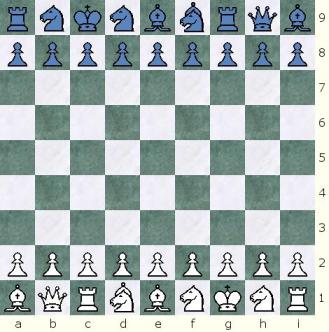
All pieces are randomly placed in the player’s first rank, with the only restriction that the King must be between the two rooks.
Procedure: Six-side Dice or Three Coins
1. Same Color Squares Allowed technique (3.2) to place the Bishops.
2. There are 7 squares left. Use the 'King can't go in the corners' technique (4.2) to place the King.
3. Use the Place the Rooks after the King technique (4.3) to place the two Rooks.
4. There are 4 empty squares left. Roll the die (1.0) or toss 2 coins (2.2) to place the Queen. Repeat this step to place the Prime Minister.
5. Place the Knights on the remaining 2 empty squares left.
Ajax Random Chess 8x8 Positions
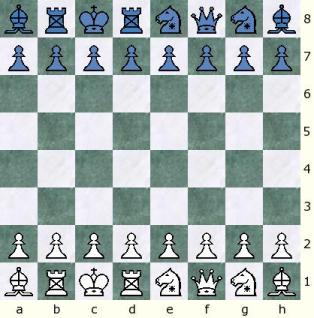 ....
....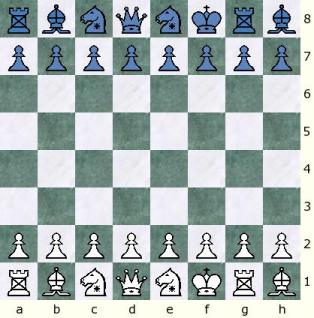
All pieces are randomly placed in the player’s first rank, with the only restriction that the King must be between the two rooks.
Procedure: Six-side Dice or Three Coins
1. Same Color Squares Allowed technique (3.2) to place the Bishops.
2. There are 6 squares available, roll the die (1.0) or toss three coins (2.3) to place the Queen
3. There are 5 squares left, roll the die (1.0) or toss three coins (2.3) to place the first Knight. Repeat the process, roll the die (1.0) or toss two coins (2.2) to place the second Knight.
4. There are 3 squares left, use the King and Rooks left for the last technique (4.1) to place them.
English Random 10x10 Positions
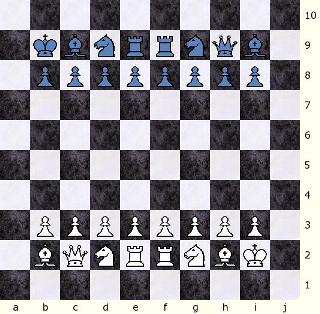
Well, actually 8x8 inside of a 10x10 board.
Totally free randomness. No restriction for the King to be between the rooks (to ensure allowing castling) or a restriction to keep the Bishops in opposite color squares.
Procedure #1: Six-side die
1. Same Color Squares Allowed technique (3.2) to place the Bishops.
2. Roll the die (1.0) to place the King. Repeat this step in turns to place the Queen and the Rooks.
3. Place the Knights on the remaining 2 empty squares left.
Procedure #2: Three Coins
1. Roll three coins (1.0) to place the King. Repeat this step in turns to place the Rooks and the Queen.
2. Roll two coins (1.0) to place the Bishops.
3. Place the Knights on the remaining 2 empty squares left.
Capablanca Random 10x8 Positions
Procedure:
1. For the normal Capablanca Random Chess position use step 1a. For the Modern Capablanca Random variant use 1b.
1a. Use the 'Opposite Color Squares' technique (3.1) to place the Bishops. Go to step 2.
1b. Same Color Squares Allowed technique (3.2) to place the Bishops. Go to step 2
2. There are 8 squares left. Use the 'King can't go in the corners' technique (4.2) to place the King.
3. Use the Place the Rooks after the King technique to place the two Rooks.
4. There are 5 empty squares left. Roll the die (1.0) or toss 3 coins (2.2) to place the Queen. Repeat this step to place the ArchBishop and the Chancellor.
5. Place the Knights on the remaining 2 empty squares left.
Korean Random 9x10 Positions
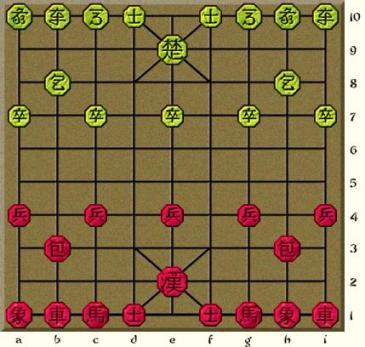
The initial position in the first row for the Rooks, Elephants and Knights is totally random, with the only restriction that you have one piece of each type at both sides of the King. There is direct simmetry accross the board for both armies.
First roll (or toss) to setup the pieces to the left of the King. Repeat the process for the set to the right of the King.
Procedure: Six-side die or Two Coins
1a. Roll the die (1.0) to place the Rook. One-Two-Three rolls are valid. For Four-Five-Six rolls just take away 3, and you will have your One-Two-Three roll.
1b. Use two coins and use the (2.2) Up to 4 choices process. Re-toss for a 4-toss.
2. Do a 'Heads or tails' Roll (1.1) or Toss (2.1) to place the Knight.
3. Place the Elephant in the last empty square.
Notes
External image links detected!
You know what would look worse on your page than this big, ugly warning? Broken image links. If you're the author, please make sure that doesn't happen to this page by replacing the following external graphic images with local copies.
Array
(
[0] => http://upload.wikimedia.org/wikipedia/commons/thumb/b/bf/Bobby_Fischer_1960_in_Leipzig.jpg/240px-Bobby_Fischer_1960_in_Leipzig.jpg
)
You may have a variation that uses a 9x9 setup with Bishops on opposite colors, or where Rooks do not have to be at either side of the King. After reading the information here, you would be able to make up your own suitable process following many of the guidelines here.
You can pick and choose from the techniques discussed above to suit your needs, it all depends on the inital layout rules for the random variation you are playing.
Enjoy generating your OTB random positions!!!
Acknowledgement / Dedication

I want to thank the late Grandmaster and former World Chess Champion Bobby Fischer (1943-2008) for breaking the "random" world of chess wide open. This page is dedicated to his memory.
Chess Variants by the Author:
- Modern Random Chess (9x9)
- Contemporary Random Chess (8x8)
- Prime Ministers Chess (9x8)
- Modern Capablanca Random Chess (10x8)
- Modern English Random Chess (10x10)
- Pseudo-Modern Random Chess (9x9)
- Chess8400 (9x9)
- Prime Ministers Contemporary Random Chess (8x8)
- Prime Ministers Random Chess (9x8)
- International Contemporary Random Chess (10x10)
- International Fischer Random Chess (10x10)
- Courier Chess Moderno (12x8)
- Mini Courier Chess Moderno (10x8)
- Silver Elephant Chess (10x8)
- Modern Ministers Courier Chess (11x8)
- Ajax Chess (10x10)
- Partnership Chaturanga (8x8)
Other Pages by the Author:
- How to Generate Random Positions
- The Bishop Adjustment Rule
- The Modern Principles
- Reverse Symmetry
- The Prime Minister
- The Courier Elephant
- The 10x8 Variants
- Modern Chess Preset
- Makruk (Thai Chess) Preset
 This 'user submitted' page is a collaboration between the posting user and the Chess Variant Pages. Registered contributors to the Chess Variant Pages have the ability to post their own works, subject to review and editing by the Chess Variant Pages Editorial Staff.
This 'user submitted' page is a collaboration between the posting user and the Chess Variant Pages. Registered contributors to the Chess Variant Pages have the ability to post their own works, subject to review and editing by the Chess Variant Pages Editorial Staff.
By Jose Carrillo.
Web page created: 2009-06-20. Web page last updated: 2009-10-15